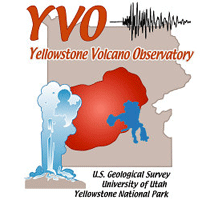About the Yellowstone Volcano Observatory
 The Yellowstone Volcano Observatory (YVO) was formed on 14 May 2001 to strengthen the long-term monitoring of volcanic and earthquake unrest in the Yellowstone National Park region. It is a collaboration of the U.S. Geological Survey (USGS), Yellowstone National Park, and the University of Utah.
The Yellowstone Volcano Observatory (YVO) was formed on 14 May 2001 to strengthen the long-term monitoring of volcanic and earthquake unrest in the Yellowstone National Park region. It is a collaboration of the U.S. Geological Survey (USGS), Yellowstone National Park, and the University of Utah.
The partnership provides for improved collaborative study and monitoring of active geologic processes and hazards of the Yellowstone Plateau volcanic field, site of the largest and most diverse collection of natural thermal features in the world and the first National Park.
According to Dr. Jacob B. Lowenstern, YVO Scientist-in-Charge, the observatory has improved the overall efforts to monitor Yellowstone's extraordinarily large and long-lived volcanic system. "This agreement is a natural evolution of our collective work over the years to track and study Yellowstone's unrest. There is no increased threat of eruptive activity at Yellowstone to cause concern at this time. We hope to use YVO to share even more of what we are learning with the public, Park visitors, and nearby residents, and to be in a better position to provide warning of any future hazardous activity."
YVO Objectives
YVO is an instrument-based monitoring facility designed for observing volcanic, hydrothermal, and earthquake activity in the Yellowstone National Park region. The principal objectives of YVO are:
- 1. To provide seismic, geodetic, and hydrologic monitoring that enables reliable and timely warnings of possible renewed volcanism and related hazards in the Yellowstone region,
- 2. To notify the NPS, other local officials, and the public of significant seismic or volcanic events,
- 3. To improve scientific understanding of tectonic and magmatic processes that influence ongoing seismicity, surface deformation, and hydrothermal activity,
- 4. To assess the long-term potential hazards of volcanism, seismicity, and explosive hydrothermal activity in the region,
- 5. To communicate effectively the results of these efforts to responsible authorities and to the public, and
- 6. To improve coordination and cooperation among the U of U, YNP, and the USGS.
-
A more stable basis to continue and to improve long-term monitoring and hazard-assessment activities,
-
A consistent and web-accessible database, and
-
Coordination amongst various other relevant projects of the the USGS, the University of Utah, and the NPS.
YVO Partners
Fundamental research by scientists of the USGS, University of Utah and the NPS as well as other institutions, with support from the NPS and the National Science Foundation (NSF), has provided a substantial conceptual framework for understanding this magmatic system and its relationship to the Yellowstone hotspot. The system is centered on a large and youthful caldera that is characterized by geologically infrequent but very large and destructive eruptions and smaller more frequent eruptions. Please note that YVO was not formed in response to an imminent volcano threat but to provide modern surveillance of this active system.Yellowstone is an active geologic area and a long-term monitoring effort has been underway in Yellowstone National Park and vicinity for many years. The monitoring primarily involves a seismic network operated by the University of Utah Seismograph Stations under a cooperative funding agreement with the USGS and with ancillary support from the NSF. In addition, GPS (Global Positioning System) and precise leveling measurements have been established and carried out by scientists of both the U of U and the USGS. Bringing together those activities within the Yellowstone Volcano Observatory provides:

